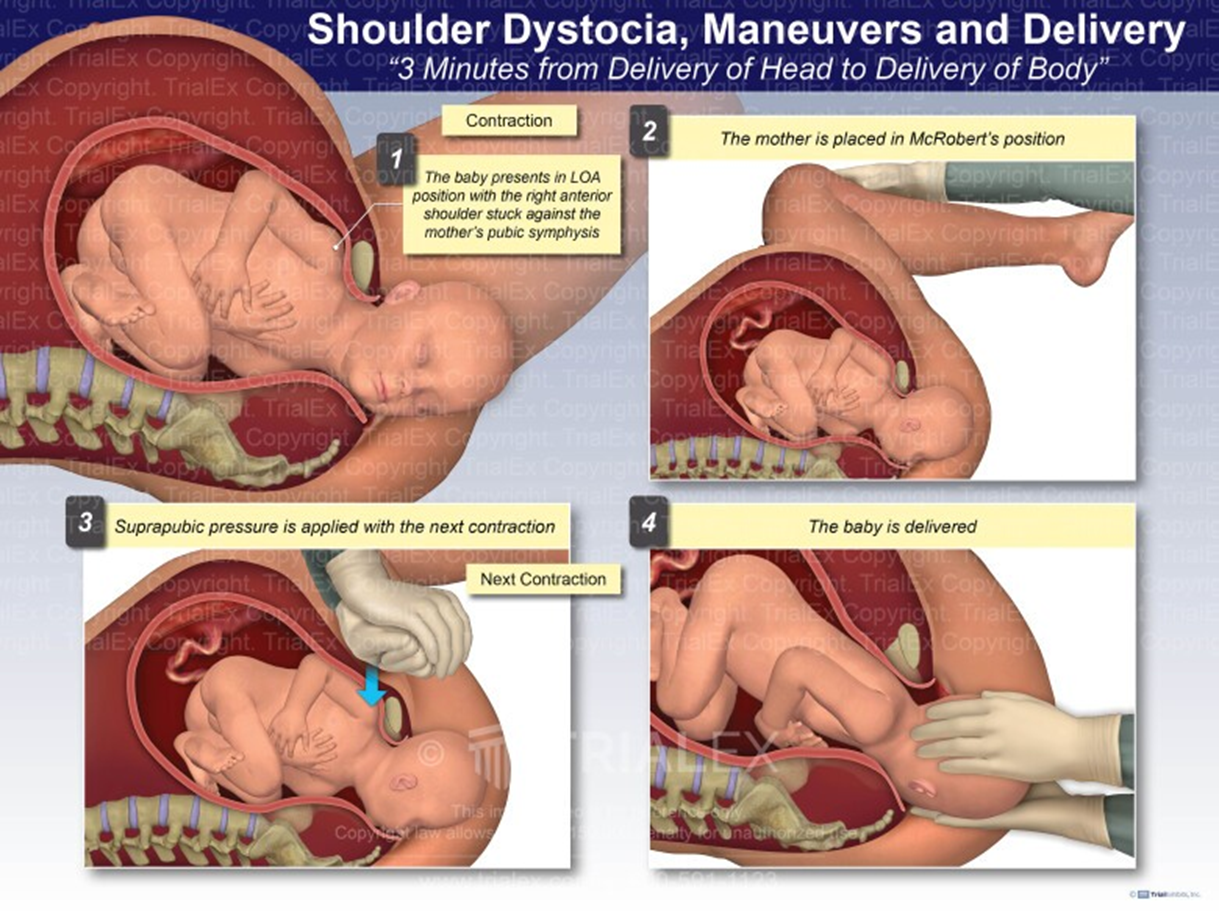A nurse is assisting with the care of a client who is in the second stage of labor.
The nurse observes retraction of the fetal head against the maternal perineum as the head is birthed.
Which of the following actions should the nurse take?
Prepare for the delivery of the shoulders.
Encourage the mother to push during the next contraction.
Call for additional medical support.
Administer pain relief medication.
The Correct Answer is A
Choice A rationale:
Normal progression of labor: After the fetal head is delivered, the shoulders typically follow immediately. The nurse should be prepared to assist with the delivery of the shoulders to ensure a safe and smooth birth process.
Significance of retraction: Retraction of the fetal head against the maternal perineum, also known as the "turtle sign," is a classic indicator of shoulder dystocia. While this sign does not guarantee shoulder dystocia, it warrants immediate preparation for potential management.
Anticipating shoulder dystocia: By anticipating the possibility of shoulder dystocia, the nurse can take proactive measures to minimize risks and facilitate delivery. These measures may include:
Positioning the mother appropriately (e.g., McRoberts maneuver)
- Applying suprapubic pressure
- Performing internal maneuvers (e.g., Rubin's maneuver)
- Breaking the clavicle (in extreme cases)

Choice B rationale:
Ineffective in shoulder dystocia: Encouraging the mother to push during the next contraction is not an effective intervention
for shoulder dystocia. In fact, excessive pushing can worsen the impaction of the shoulders and potentially lead to
complications such as fetal hypoxia, brachial plexus injury, or maternal perineal trauma.
Choice C rationale:
Necessary in confirmed dystocia: Calling for additional medical support is crucial if shoulder dystocia is confirmed. However,
immediate preparation for shoulder delivery should commence without delay, as prompt action is essential to prevent adverse
outcomes.
Choice D rationale:
Secondary concern: While pain relief medication may be administered for maternal comfort, it is not a priority intervention in
this situation. The primary focus should be on managing the potential shoulder dystocia and ensuring the safe delivery of the
baby.
Nursing Test Bank
Naxlex Comprehensive Predictor Exams
Related Questions
Correct Answer is C
Explanation
Choice A rationale:
Swelling in both breasts is a common finding in breastfeeding women, especially in the early postpartum period. It is often due
to engorgement, which is caused by an oversupply of milk and/or infrequent milk removal.
While engorgement can sometimes lead to mastitis, it is not a definitive sign of the condition.
Other causes of bilateral breast swelling, such as milk stasis or plugged ducts, should also be considered.
Choice B rationale:
Cracked and bleeding nipples can be a symptom of mastitis, but they are not always present.
They can also be caused by other factors, such as improper latch, thrush, or dry skin.
It is important to assess for other signs and symptoms of mastitis, such as fever, chills, and breast tenderness, to make a
definitive diagnosis.
Choice C rationale:
A red and painful area in one breast is a classic sign of mastitis.
This is typically caused by inflammation of the breast tissue, often due to a bacterial infection.
The redness and pain are usually localized to the affected area, and may be accompanied by warmth, swelling, and firmness.
Choice D rationale:
An increase in breast milk production is not a sign of mastitis.
In fact, it is often a sign that breastfeeding is going well.
However, if the milk is not being removed effectively, it can lead to engorgement and blocked ducts, which can increase the
risk of mastitis.
Correct Answer is B
Explanation
Choice A rationale:
There is no evidence to suggest that epidural anesthesia delays the rupture of fetal membranes. The timing of rupture of fetal
membranes is influenced by various factors, including the strength of uterine contractions, the position of the baby, and the
elasticity of the amniotic sac. Epidural anesthesia does not directly affect these factors.
Choice B rationale:
Epidural anesthesia can prolong labor by interfering with the natural process of labor. It can weaken uterine contractions,
slow down cervical dilation, and potentially lead to a prolonged second stage of labor. This is because the anesthesia blocks the
nerve signals that control the muscles of the uterus. When these signals are blocked, the contractions may become less
frequent and less intense. This can delay the progress of labor and increase the risk of interventions such as forceps delivery
or cesarean section.
Choice C rationale:
While epidural anesthesia can have some effects on the baby, it is not a primary cause of fetal depression. Fetal depression is
typically caused by other factors, such as decreased oxygen supply to the baby, maternal infection, or placental problems.
Epidural anesthesia can sometimes lead to a temporary decrease in the baby's heart rate, but this is usually well-managed by
the healthcare team and does not typically lead to significant fetal depression.
Choice D rationale:
Epidural anesthesia does not typically cause maternal hypertension. In fact, it can sometimes have the opposite effect and
cause a slight decrease in blood pressure. This is because the anesthesia can relax the blood vessels, which can lead to a drop
in blood pressure. However, this is usually not a significant concern and is easily managed by the healthcare team.
Whether you are a student looking to ace your exams or a practicing nurse seeking to enhance your expertise , our nursing education contents will empower you with the confidence and competence to make a difference in the lives of patients and become a respected leader in the healthcare field.
Visit Naxlex, invest in your future and unlock endless possibilities with our unparalleled nursing education contents today
Report Wrong Answer on the Current Question
Do you disagree with the answer? If yes, what is your expected answer? Explain.
Kindly be descriptive with the issue you are facing.
